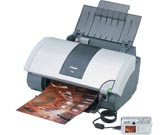Expensive printer food: When to reach for a refill
 Stuttgart - It's easy to feel like you saved money when you bring home an inkjet printer. The devices themselves are often inexpensive. Yet reality usually sets in when it comes to refilling the printer cartridges. A set of black and coloured inks often costs at least 50 dollars or more, sometimes putting the expenditure on a par with the printer itself.
Stuttgart - It's easy to feel like you saved money when you bring home an inkjet printer. The devices themselves are often inexpensive. Yet reality usually sets in when it comes to refilling the printer cartridges. A set of black and coloured inks often costs at least 50 dollars or more, sometimes putting the expenditure on a par with the printer itself.
"It's quite reasonable to suspect that the manufacturers make their profits on the ink - which is why they offer the devices themselves very affordably," says Hannelore Brecht-Kaul from the Consumer Central of Baden-Wurttemberg in Stuttgart.
"It is, however, possible to switch to printer cartridges from other manufacturers," the consumer advocate notes. Imitation or refilled ink cartridges are available for most printer models, and they often cost as much as 50 per cent less than the originals.
The search for cheaper ink should not be made blindly, however, warns Johannes Schuster from the Hanover-based computer magazine c't: both the colour and the composition of the ink must be correct. Overly viscous ink cannot flow to the jets quickly enough, while overly runny ink can leak or smudge on the paper. The alternative inks should be adapted for the respective printer model.
"With most inks there are also compromises made in terms of light-fastness."
There's no easy answer regarding which inks are good and which are poor. That varies by manufacturer and printer model. Almost all major computer magazines have tested alternative inks at one point or another. Their findings: "It's certainly theoretically possible to achieve good print quality using replacement inks while saving money," Schuster says. But relying on the manufacturers' claims alone is not enough. Brecht-Kaul, the consumer advocate, recommends researching the alternative inks thoroughly before buying.
A more affordable option than original or alternative cartridges is refilling them on your own. The process requires a steady hand and a bit of talent. Refills offer the best potential savings - but also the greatest possibility of calamity.
Refilling a cartridge involves removing it from the printer and then drilling a small hole into the casing. Needles, a small drill or even a hot paper clip will suffice. Ink is then filled in using a needle and then the hole is sealed airtight.
Beyond the obvious risk of ink stains on your pants, do-it-yourselfers also run the risk of their printer rejecting the refilled cartridge. Many printer cartridges are now equipped with a chip that notes their fill levels. Simply refilling the cartridges does not trick the chip. It must either be reset using software, taped over or otherwise rendered inoperable.
Yet the chip is also the key element in the empty-cartridge warning system. If the chip is disabled, the user needs to actively mind the ink levels. Printing on an empty cartridge can destroy the printer in a hurry.
Ink refill stations have sprung up to take over a portion of the work: They fill empty cartridges and ensure that the chip is functioning properly. "Our refilled cartridges are 40 to 60 per cent cheaper than the original models," says Antje Kiewitt from Cartridge World. Cartridges can be refilled between three and seven times before the print heads are too worn down.
While there are a variety of alternatives to the pricy original ink cartridges, sometimes the savings just aren't worth the risk.
"Those who print only a little aren't well served by the alternative inks, given the complexity of refilling them and sacrifices in terms of quality," Schuster says. In that case, original is the way to go.
INFO BOX: Printers often warn of empty cartridges too soon
Nobody wants to waste valuable printer ink. Yet many printers more or less force the issue, reports a study by TUEV Rheinland. Many models warn that their cartridges are empty before it is really time to change them. This leads consumers to change them even though they could have printed a bit longer.
"This means that at least 20 per cent of the ink is wasted on a regular basis," says Hartmut Mueller-Gerbes from TUEV Rheinland. Printers with individual tanks for the separate colours tended to perform better than those with all colours in one. (dpa)